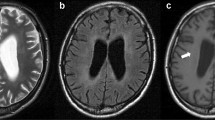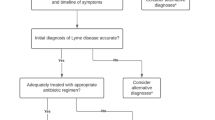Abstract
The potential mechanisms for blood–brain barrier damage and the diagnosis of neurosyphilis in HIV patients co-infected with syphilis (HIV-S) are unclear. The aim of the study was to determine the expression of CXCL2 in the serum and cerebrospinal fluid (CSF) of HIV-S patients. A total of 34 HIV patients and 7 controls were enrolled in a HIV clinical cohort for diagnosis of neurosyphilis in Taiwan. Serum and CSF concentrations of CXCL2 were determined by ELISA. Neurosyphilis was defined as a CSF white blood cell count of ≧20 cells/μl or a reactive CSF Venereal Disease Research Laboratory (VDRL). Demographics and medical histories were collected. All the patients with HIV-S were males. Most (80 %) had sex with men (MSM) and serum rapid plasma reagin (RPR) titers of ≧1:32. The medium age was 37 (range 21–68) years. The medium CD4 T cell counts at the time of the diagnosis of syphilis were 299 (range 92–434) cells/μl. Eight patients (24 %) had neurosyphilis based on a reactive CSF VDRL test (n = 5) or increased CSF white blood cell counts of ≧20 cells/μl (n = 3). The concentrations of CSF CXCL2 were significantly higher in patients with HIV and neurosyphilis as compared to HIV with syphilis, HIV, and controls (p = 0.012). There were no significant differences in serum concentrations between the four groups. There was a correlation between CSF CXCL2 concentrations with neurosyphilis (p = 0.017), CSF white blood cell count (p = 0.001), and CSF protein levels (p = 0.005). The CSF level of CXCL2 can be used to distinguish those with or without neurosyphilis in HIV infected patients.


Similar content being viewed by others
References
Sadiq, S.T., J. McSorley, A.J. Copas, J. Bennett, S.J. Edwards, S. Kaye, S. Kirk, P. French, and I.V. Weller. 2005. The effects of early syphilis on CD4 counts and HIV-1 RNA viral loads in blood and semen. Sexually Transmitted Infections 81: 380–385.
Kofoed, K., J. Gerstoft, L.R. Mathiesen, and T. Benfield. 2006. Benfield T. Syphilis and human immunodeficiency virus (HIV)-1 coinfection: influence on CD4 T-cell count, HIV-1 viral load, and treatment response. Sexually Transmitted Diseases 33: 143–148.
Palacios, R., F. Jimenez-Onate, M. Aguilar, M.J. Galindo, P. Rivas, A. Ocampo, J. Berenguer, J.A. Arranz, M.J. Ríos, H. Knobel, F. Moreno, J. Ena, and J. Santos. 2007. Impact of syphilis infection on HIV viral load and CD4 cell counts in HIV-infected patients. Journal of Acquired Immune Deficiency Syndromes 44: 356–359.
Flood, J.M., H.S. Weinstock, M.E. Guroy, L. Bayne, R.P. Simon, and G. Bolan. 1998. Neurosyphilis during the AIDS epidemic, San Francisco, 1985–1992. Journal of Infectious Diseases 177: 931–940.
Berry, C.D., T.M. Hooton, A.C. Collier, and S.A. Lukehart. 1987. Neurologic relapse after benzathine penicillin therapy for secondary syphilis in a patient with HIV infection. New England Journal of Medicine 316: 1587–1589.
DiNubile, M.J., F.J. Copare, and K.M. Gekowski. 1990. Neurosyphilis developing during treatment of secondary syphilis with benzathine penicillin in a patient without serologic evidence of human immunodeficiency virus infection. American Journal of Medicine 88: 45N–48N.
Workowski, K.A., and S.M. Berman. 2006. Sexually transmitted diseases treatment guidelines, 2006. MMWR—Recommendations and Reports 55: 1–94.
Marra, C.M., C.L. Maxwell, S.L. Smith, S.A. Lukehart, A.M. Rompalo, M. Eaton, B.P. Stoner, M. Augenbraun, D.E. Barker, J.J. Corbett, M. Zajackowski, C. Raines, J. Nerad, R. Kee, and S.H. Barnett. 2004. Cerebrospinal fluid abnormalities in patients with syphilis: association with clinical and laboratory features. Journal of Infectious Diseases 189: 369–376.
Libois, A., S. De Wit, B. Poll, F. Garcia, E. Florence, A. Del Rio, P. Sanchez, E. Negredo, M. Vandenbruaene, J.M. Gatell, and N. Clumeck. 2007. HIV and syphilis: when to perform a lumbar puncture. Sexually Transmitted Diseases 34: 141–144.
Wolpe, S.D., B. Sherry, D. Juers, G. Davatelis, R.W. Yurt, and A. Cerami. 1989. Identification and characterization of macrophage inflammatory protein 2. Proceedings of the National Academy of Sciences of the United States of America 86: 612–616.
Nygårdas, P.T., J.A. Määttä, and A.E. Hinkkanen. 2000. Chemokine expression by central nervous system resident cells and infiltrating neutrophils during experimental autoimmune encephalomyelitis in the BALB/c mouse. European Journal of Immunology 30: 1911–1918.
Rupprecht, T.A., A. Plate, M. Adam, M. Wick, S. Kastenbauer, C. Schmidt, M. Klein, H.W. Pfister, and U. Koedel. 2009. The chemokine CXCL13 is a key regulator of B cell recruitment to the cerebrospinal fluid in acute Lyme neuroborreliosis. Journal of Neuroinflammation 6: 42.
Marra, C.M., L.C. Tantalo, S.K. Sahi, C.L. Maxwell, and S.A. Lukehart. 2010. CXCL13 as a cerebrospinal fluid marker for neurosyphilis in HIV-infected patients with syphilis. Sexually Transmitted Diseases 37: 283–287.
Marra, C.M., L.C. Tantalo, C.L. Maxwell, K. Dougherty, and B. Wood. 2004. Alternative cerebrospinal fluid tests to diagnose neurosyphilis in HIV-infected individuals. Neurology 63: 85–88.
Liu, L.L., P.L. Chao, H.L. Zhang, M.L. Tong, G.L. Liu, L.R. Lin, Y.H. Su, J.Y. Wu, J. Dong, W.H. Zheng, and T.C. Yang. 2013. Analysis of lymphocyte subsets in HIV-negative neurosyphilis patients. Diagnostic Microbiology and Infectious Disease 75: 165–168.
Acknowledgments
This work was supported by a Summer Medical Student Research Program, from the Medical Foundation in Memory of Dr. Deh-Lin Cheng and also from the Yen Tjing Ling Medical Foundation.
Conflicts of interest
The authors report no financial conflicts of interest.
Author information
Authors and Affiliations
Corresponding authors
Rights and permissions
About this article
Cite this article
Tsai, HC., Ye, SY., Lee, S.SJ. et al. Expression of CXCL2 in the Serum and Cerebrospinal Fluid of Patients with HIV and Syphilis or Neurosyphilis. Inflammation 37, 950–955 (2014). https://doi.org/10.1007/s10753-014-9815-3
Published:
Issue Date:
DOI: https://doi.org/10.1007/s10753-014-9815-3




